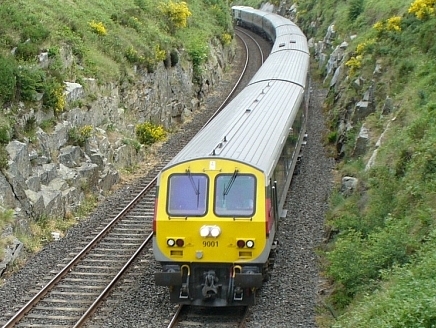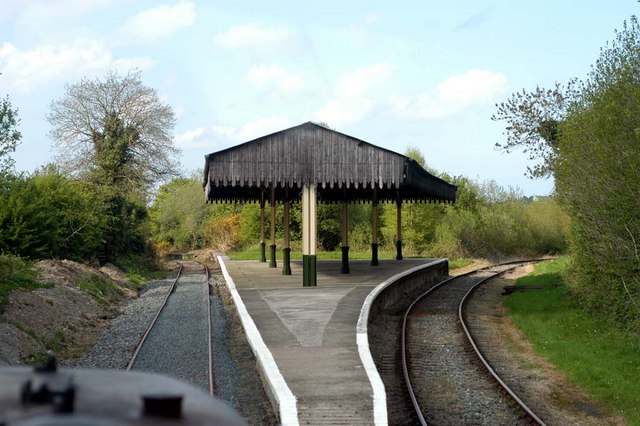|
GSR Class J30
The Great Southern and Western Railway Class 90 is a class of steam locomotive. They were one of the smallest steam locomotives to be inherited by the CIÉ on its formation. History In 1875 Inchicore Works outshopped two railmotors, steam locomotives with a carriage on the same chassis to work the Castleisland and Gortatlea Light Railway. Both railmotors were rebuilt (the first in 1890) removing the carriage portion and leaving the locomotive as a small and light . The two examples were numbered 90 and 100 and were put to work in the Cork area. Unusually, the centre driving wheels were flangeless giving very good working over tight radius tracks. They regularly shunted along the quayside at Cork and worked the car trains from the Ford works to Rocksavage yard. In the summer months both locomotives were coupled together to work the excursion trains on the lightly laid Timoleague and Courtmacsherry Light Railway The Timoleague and Courtmacsherry Railway was a long ... [...More Info...] [...Related Items...] OR: [Wikipedia] [Google] [Baidu] |
Inchicore Works
Inchicore railway works, also known locally as 'Inchicore' or 'The Works', was founded by the Great Southern and Western Railway in 1846 and emerged to become the major engineering centre for railways in Ireland. Located west of Dublin city centre, the works cover an area of approximately . The works are responsible for the overhaul, repair, servicing, spraying and washing of locomotives and rolling stock. In the past, the manufacture, assembly and rebuild of locomotives and rolling stock has been performed at Inchicore. History When the works was opened in 1846, there were a total of 39 employed at the facility. The locomotive erecting shop had 18 pits on one side and 16 on the other. By 1886, the works had expanded to 52 acres. In 1934 the erecting shop was replaced by a building with through roads. In 1976 the works employed over one thousand people and was 72 acres in size. Site The works are situated alongside and to the south of the Dublin to Cork main line about ... [...More Info...] [...Related Items...] OR: [Wikipedia] [Google] [Baidu] |
Inchicore
Inchicore () is a suburb of Dublin, Ireland. Located approximately west of the city centre, Inchicore was originally a small village separate from Dublin. The village developed around Richmond Barracks (built 1810) and Inchicore railway works (built 1846), before being incorporated into the expanding city bounds. Inchicore is a largely residential area and is home to the association football club St Patrick's Athletic FC. History Inchicore grew from a small village near a marsh on the River Camac at ''Inse Chór '' or ''Inse Chaoire''. Some sources suggest that ''Inse Chaoire'' means "sheep island", referring to the spot where sheep were herded and watered outside Dublin city prior to market. Other sources, including the Placenames Database of Ireland, do not give a definitive source for the place name. In the late 19th century, the village developed into a significant industrial and residential suburb, due primarily to its engineering works and the west city tramway terminus. ... [...More Info...] [...Related Items...] OR: [Wikipedia] [Google] [Baidu] |
Steam Locomotives Of Northern Ireland
Steam is a substance containing water in the gas phase, and sometimes also an aerosol of liquid water droplets, or air. This may occur due to evaporation or due to boiling, where heat is applied until water reaches the enthalpy of vaporization. Steam that is saturated or superheated is invisible; however, "steam" often refers to wet steam, the visible mist or aerosol of water droplets formed as water vapor condenses. Water increases in volume by 1,700 times at standard temperature and pressure; this change in volume can be converted into mechanical work by steam engines such as reciprocating piston type engines and steam turbines, which are a sub-group of steam engines. Piston type steam engines played a central role in the Industrial Revolution and modern steam turbines are used to generate more than 80% of the world's electricity. If liquid water comes in contact with a very hot surface or depressurizes quickly below its vapor pressure, it can create a steam explosion. Types ... [...More Info...] [...Related Items...] OR: [Wikipedia] [Google] [Baidu] |
Coaching Stock Of Ireland
A wide variety of hauled coaches have been used on the railways of Ireland. This page lists all those since 1945. Ireland When formed in 1945, Córas Iompair Éireann (CIÉ) inherited from its constituents a motley collection of coaching stock from various manufacturers, in equally variegated conditions of repair. Although many were over 40 years old they had to remain in service until a programme of replacement could be found. CIÉ, which controlled the Republic's railways between 1945 and 1987, and its subsidiary, Iarnród Éireann (IÉ) from 2 February 1987, have made great use of hauled coaches, though in recent years IÉ has turned increasingly to multiple units to replace old locomotives and coaches. IÉ and NIR jointly own the current stock used on the ''Enterprise'' service between Dublin and Belfast, with IÉ nominally owning the odd-numbered vehicles and NIR the even-numbered ones, though all share a common ''Enterprise'' livery. Current stock De Dietrich (1997–pre ... [...More Info...] [...Related Items...] OR: [Wikipedia] [Google] [Baidu] |
Diesel Locomotives Of Ireland
Although prototype diesel locomotives ran in Britain before World War II, the railways of both the Republic and Northern Ireland changed over much more rapidly from steam to diesel traction than those in Britain, due to the island's limited coal reserves and (in the Republic) an ageing steam locomotive fleet. Northern Ireland operated several diesel shunters as early as the 1930s. CIE's first diesels consisted of five shunters built by CIE in 1947/48. The initial two diesel mainline locomotives were also built in Inchicore, in 1950/51, and fitted with Sulzer engines and MV traction equipment. This was followed in the mid 1950s with a large order from Britain fitted with Crossley engines, with notably poor results. From the early 1960s, locomotives with more reliable engines from General Motors Electro-Motive Division were adopted. In the late 1960s the Crossley engines were replaced by EMD 645 units in a major re-enginging programme. Since the early 1960s all new locomotives ... [...More Info...] [...Related Items...] OR: [Wikipedia] [Google] [Baidu] |
Downpatrick And County Down Railway
The Downpatrick and County Down Railway (DCDR) is a five-foot, three-inch (1,600 mm) gauge heritage railway in County Down, Northern Ireland. It is operated by volunteers and runs passenger trains using steam and diesel locomotives, diesel railcars, and vintage carriages. The railway has approximately three miles (4.8 km) of track in a triangular-shaped layout, which connects the town of Downpatrick with the historical sites of Inch Abbey to the north and King Magnus’ Grave to the south. It also houses a museum of railway artefacts and rolling stock originating from both Northern Ireland and the Republic of Ireland, dating from the 1860s to the 1980s. The DCDR’s development was spearheaded by a group of local railway enthusiasts in the early 1980s, and work started on building the railway in 1985. Most of its track is on part of the now-closed Belfast and County Down Railway (BCDR) mainline which ran between Belfast, Downpatrick, and Newcastle. The heritage ra ... [...More Info...] [...Related Items...] OR: [Wikipedia] [Google] [Baidu] |
Railway Preservation Society Of Ireland
The Railway Preservation Society of Ireland (RPSI) is an Irish railway preservation group operating throughout Ireland, founded in 1964. Mainline steam train railtours are operated from Dublin and Belfast, but occasionally from other locations as well. The society has bases in Dublin and Whitehead, County Antrim, with the latter hosting a museum and occasionally operating short steam rides within the confines of its site. The society owns heritage wagons, carriages, steam engines, diesel locomotives and metal-bodied carriages suitable for mainline use. Bases The society has developed several bases over time, with Whitehead joined by Sallins, then Mullingar, and also Inchicore and Connolly in Dublin. As of 2019, three locations are in operation, Whitehead, Inchicore and Connolly. Current operations Whitehead site and museum Whitehead has a long history as a working steam and engineering depot. This was added to by the development of a museum. The Whitehead Railway Museum ope ... [...More Info...] [...Related Items...] OR: [Wikipedia] [Google] [Baidu] |
Mallow Railway Station
Mallow railway station is an Irish station on the Dublin-Cork railway line, Mallow-Tralee railway line and Cork Suburban Rail ( Cork Kent, Cobh and Midleton). Facilities Mallow's main station building is located on the south side of the railway tracks, nearest to the town, and is constructed from the grey stone typical of many Irish stations. It houses the booking office, administration accommodation and other facilities. There is a covered footbridge at the south-west end which enables passengers to reach the two other platforms, which are all through platforms. It is the transfer station for passengers changing onto the Mallow–Tralee line. The station was acclaimed as Iarnród Éireann's best overall station in 2004. Location The station is located in Annabella, just outside Mallow, in north County Cork. It is situated just north of the junction between the lines from Cork and Tralee. It is two miles from Cork Racecourse. History The station opened on 17 March 1849. ... [...More Info...] [...Related Items...] OR: [Wikipedia] [Google] [Baidu] |
Timoleague And Courtmacsherry Light Railway
The Timoleague and Courtmacsherry Railway was a long light railway connecting Timoleague station and Courtmacsherry station. It was the last roadside railway operating in Ireland. History The railway was incorporated in October 1888 and opened on 21 April 1891. It was originally considered to be built as a narrow gauge track but then executed as a standard gauge light railway, partly running along a road. There were two companies, the ''Timoleague & Courtmacsherry Light Railway'' and the ''Ballinascarthy & Timoleague Junction Light Railway'' which were both worked by the ''Timoleague & Courtmacsherry Extension Light Railway''. It became a constituent of ''Great Southern Railways'' in 1925. or according to other sources on 23 February 1891 It was originally operated by two locomotives, both from the Leeds works of the Hunslet Engine Company, named '' Slaney'' and '' St. Molaga''. These two were joined in 1894 by a third locomotive, again from Hunslet, with the name '' Argade ... [...More Info...] [...Related Items...] OR: [Wikipedia] [Google] [Baidu] |
.jpg)





